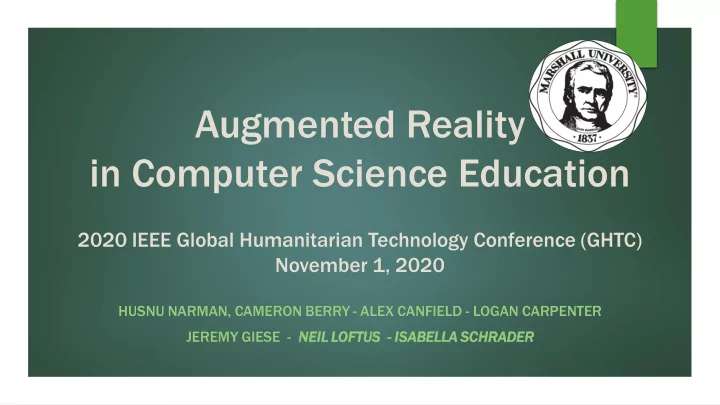

Augmented Reality in Computer Science Education 2020 IEEE Global Humanitarian Technology Conference (GHTC) November 1, 2020 HUSNU NARMAN, CAMERON BERRY - ALEX CANFIELD - LOGAN CARPENTER JEREMY GIESE - NEIL LOFTU TUS S - ISABEL ELLA SCHRADER ER
Outline: Introduction Design Process System Features Examples Conclusion
Problem: The concept of data structures in computer science is quite challenging to visualize. Thus, computer science students often have difficulty understanding the subject.
Previous Solutions: Open DSA JGRASP Visualization Visualgo Many more based on Visual and Practice
Limitations: Not embed real-life even if they visualize the data structures.
Our Approach: The project is centered on an augmented reality program which allows students to visualize the aforementioned data structures ARCSE (Augmented Reality Computer Science Education) Display multiple different data structures Provide simple explanations to aid in learning
Design Process: Menu controls are easy to provide an easier experience for the user The overall appearance of the application should be informative and engage students.
Software Utilized:
System Diagram:
System Features: Data Structures Included: Learn by doing: Stack Adding Array List Removing Linked List Indexing Queue Object Binary Search
System Features: Adding /Removing
System Features: Linked List
System Features: Array List
System Features: Stack
System Features : Queue
System Features: Binary Search Tree
Results: Multiple studies were conducted to view the effect of AR learning on a student’s understanding of a topic. Actual classes with students were split and groups were given different methods of learning data structures.
Results (cont.) Students split into three groups, each utilizing a different teaching method: AR App, VisuAlgo, and Paper Each teaching method was used for 15 minutes 13 Students Linked List Array List Stack (15 mins) (15 mins) (15 mins) Group 1 AR App VisuAlgo Paper Group 2 VisuAlgo Paper AR App Group 3 Paper AR App VisuAlgo
Results (cont.) Most engaging teaching method VisuAlgo 8% Paper 8% Paper AR App VisuAlgo AR App 84%
Results (cont.) Which tool best helps understanding? Paper VisuAlgo 31% 31% Paper AR App VisuAlgo AR App 38%
Results (cont.) Should AR/VR be integrated into classes? No No 15% AR App AR App 85%
Conclusions / Final Thoughts: Integrating Augmented Reality into computer science education is a valuable tool and would greatly help the field Through ARCSE, students can comprehend highly difficult problems in a more engaging manner Students, teachers, and anyone interested in computer science would all benefit from ARCSE
Demo: Now, it is demo of the application to show how it works.
Questions?
Recommend
More recommend